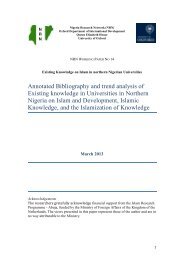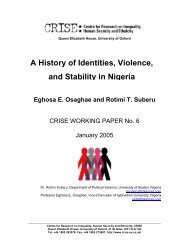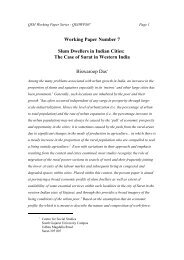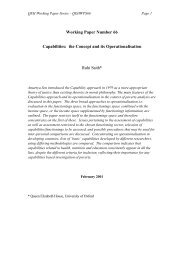<strong>Acute</strong> <strong>Multidimensional</strong> <strong>Poverty</strong>: A <strong>New</strong> <strong>Index</strong> <strong>for</strong> <strong>Developing</strong> CountriesAlkire & SantosThe WHS was designed by the World Health Organization (WHO hereafter) and implemented <strong>for</strong>the first time in 2003 in 70 countries (both developing and developed) by different institutions ineach country with the technical assistance and guidance of WHO. We use WHS datasets <strong>for</strong> 19countries, all correspond to 2003.The three surveys´ datasets used to compute the MPI are nationally representative samples ofhouseholds. Two points are worth noting. First, in all surveys the samples are optimized with multistagestratified designs. Second, these surveys aim to provide accurate in<strong>for</strong>mation on certain healthindicators (such as fertility and child mortality). There<strong>for</strong>e, the sample design makes sure to selectenough number of cases from the relevant population to reduce the sampling error in suchindicators. Because of these two characteristics, when the sample is not self weighted, we used thesample weight provided in the datasets to calculate the poverty estimations. In this way we ensurethe actual national representativeness of the results. In the three surveys, the sample weights areadjusted by non-response. Not using the sample weights would produce bias towards the clusters orgroups of population that were oversampled according to the survey design.In addition to the three mentioned surveys, two country-specific surveys were also used: theEncuesta Nacional de Salud y Nutrición (ENSANUT hereafter) of Mexico, conducted in 2006, andthe Encuesta Nacional de Nutrición y Salud (ENNyS) of Argentina conducted in 2004-2005. 36 Noother survey with the required indicators was available <strong>for</strong> these two countries. ENSANUT has anationally representative sample of households and collects indicators that are comparable withthose in the other three surveys. However, un<strong>for</strong>tunately, ENNyS is the only survey we use that isnot nationally representative. First, it was conducted only in urban areas; second, the sample designand survey weights do not allow nationally representative estimates in urban areas. However, wekept these estimates as a lower bound estimate of acute multidimensional poverty in the urban areasof Argentina. 37We have estimated the MPI <strong>for</strong> a total of 104 developing countries where one of the mentionedsurveys with in<strong>for</strong>mation on the relevant indicators was available. Of the 104 countries, 24 are inCentral and Eastern Europe and the Commonwealth of Independent States (CIS), 11 are ArabStates, 18 countries are in Latin America and the Caribbean, 9 in East Asia and the Pacific, 5 inSouth Asia, and 37 countries in Sub-Saharan Africa. Overall they add up to a total population of 5.2billion people, which is about 78.4 percent of the total world population (using 2007 populationdata, HDR, 2009).3.2 Available in<strong>for</strong>mation in each surveyThe preference of DHS over MICS and of MICS over WHS is partly due to the availability ofindicators in each survey. In general, DHS contains more complete in<strong>for</strong>mation on the tenindicators. In what follows we briefly describe differences in the indicators across the differentsurveys by dimension.36 We also per<strong>for</strong>med estimations with two other country-specific surveys: the China Health and Nutrition Survey –Cross Section 2006 (CHNS) and the 2007 South Africa Community Survey (CS). However, in both cases we decided touse the WHS results <strong>for</strong> these countries. In the case of China, because the CHNS is not nationally representative – itonly covers nine provinces. In the case of South Africa, the CS lacks nutritional in<strong>for</strong>mation and the (women) samplesize of the mortality questionnaire to which we have access is too small (3000 observations out of a total of 900,000individuals).37 It is well known that rural areas in Argentina (which are not covered systematically by any survey), especially in thenorthern regions, are significantly poorer than urban ones.www.ophi.org.uk July 2010 22
<strong>Acute</strong> <strong>Multidimensional</strong> <strong>Poverty</strong>: A <strong>New</strong> <strong>Index</strong> <strong>for</strong> <strong>Developing</strong> CountriesAlkire & SantosNutritionDHS contains nutritional in<strong>for</strong>mation on women between 15 and 49 years (Body Mass <strong>Index</strong>, BMIhereafter) and on the under-5-year-old children of the household (weight and height). As explainedin Section 2, this allows constructing a composite indicator which considers a household to bedeprived (and there<strong>for</strong>e all its members) if there is either a woman or a child undernourished in thehousehold. MICS contains nutritional in<strong>for</strong>mation only on the under-5-year-old children of thehousehold whereas WHS provides nutritional in<strong>for</strong>mation only on the survey respondent, that is anyadult (18 years old and older), either male or female. There<strong>for</strong>e, <strong>for</strong> countries with these surveys, thenutritional indicator is determined only with the in<strong>for</strong>mation of one of the two components used incountries with DHS. ENSANUT provides nutritional in<strong>for</strong>mation on all household members, ofany age, whereas ENNyS provides nutritional in<strong>for</strong>mation on under-5-year-old children and womenof 10 to 49 years of age. There<strong>for</strong>e, both ENSANUT and ENNyS allow the construction of anindicator similar to the DHS (though ENSANUT includes males, and both include a wider agerange).As explained in Section 2, the nutritional indicator <strong>for</strong> children is the weight-<strong>for</strong>-age. A child isunderweight if he or she is two or more standard deviations below the median of the referencepopulation. This is one of the indicators proposed by the MDGs to track progress in Goal 1:Eradicate Extreme poverty and Hunger. As a robustness check we also per<strong>for</strong>med estimations withtwo other well-known nutritional indicators <strong>for</strong> children: weight-<strong>for</strong>-height and height-<strong>for</strong>-age. 38 Toguarantee strict comparability of the nutritional indicators <strong>for</strong> children across surveys, we estimatedthem in all cases (DHS, MICS, ENSANUT, and ENNyS) following the algorithm provided by theWHO Child Growth Standards. 39 This algorithm uses a reference population constructed by theWHO Multicentre Growth Reference Study (MGRS), which was implemented between 1997 and2003. The study involved 8,000 healthy children from Brazil, Ghana, India, Norway, Oman, and theUnited States, living under conditions likely to favor achievement of their full genetic growthpotential. The study was purposely designed to produce a standard rather than a reference. Itthere<strong>for</strong>e provides a solid foundation to determine abnormal growth 4038 “The weight-<strong>for</strong>-age indicator reflects body mass relative to chronological age and is influenced by both the height ofthe child (height-<strong>for</strong>-age) and weight-<strong>for</strong>-height. Its composite nature makes interpretation complex. For example,weight <strong>for</strong> age fails to distinguish between short children of adequate body weight and tall, thin children. Low height <strong>for</strong>age or stunting, defined as minus two standard deviations from the median height <strong>for</strong> the age of the referencepopulation, measures the cumulative deficient growth associated with long-term factors, including chronic insufficientdaily protein intake. Low weight <strong>for</strong> height or wasting, defined as below minus 2 standard deviations from the medianweight <strong>for</strong> height of the reference population, indicates, in most cases, a recent and severe process of weight loss, oftenassociated with acute starvation or severe disease. When possible, all three indicators should be analysed and presentedsince they measure and reflect different aspects of child malnutrition.” (United Nations, 2003). The effect of usingdifferent nutritional indicators is further discussed in the Section 4.7.39 http://www.who.int/childgrowth/software/en/40 DHS and MICS provide the children´s nutrition z-scores as already computed variables. However, these computationsare based on the National Center <strong>for</strong> Health Statistics (NCHS)/WHO growth reference that had been recommended <strong>for</strong>international use since the late 1970s (WHO, 1995). “The limitations of the NCHS/WHO reference have beendocumented (WHO Working Group on Infant Growth, 1994; de Onis and Yip, 1996; de Onis and Habicht, 1996). Thedata used to construct this reference covering birth to three years of age came from a longitudinal study of children ofEuropean ancestry from a single community in the USA. These children were measured every three months, which isinadequate to describe the rapid and changing rate of growth in early infancy. Also, the statistical methods available atthe time the NCHS/WHO growth curves were constructed were too limited to correctly model the pattern andvariability of growth. As a result, the NCHS/WHO curves do not adequately represent early childhood growth” (WHOMulticentre Growth Reference Study Group 2006 report, Chapter 1, p. 1). There<strong>for</strong>e, now the WHO recommends usingwww.ophi.org.uk July 2010 23













